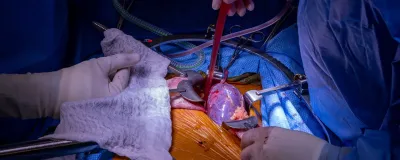
Photo Essay: The Rush Transplant Program
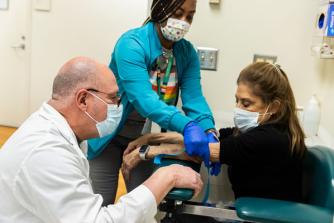
Multidisciplinary approach
The most commonly asked question referring providers ask Nathalie Sela, MD: “Will my patient be taken care of?”
The answer is a resounding “yes.” With wraparound care before, during and after transplant, patients are well looked after. Recipients and donors are supported by a multidisciplinary care team that includes the surgical staff, transplant coordinator, nursing team, social worker and transplant educator, all of whom guide the patients through the transplant process to ensure optimal outcomes.
Months before Karen Cotler (right, seated) received a kidney from her brother Scott Feldman, they both underwent several screening evaluations to make sure they were suitable candidates for transplant.

Commitment for equitable access
Dr. Sela (seated right) explains to Karen what she can expect during and after transplant.
Not everyone is an automatic candidate to donate or receive an organ. According to Dr. Sela, some patients require more medical or psychosocial resources to support during transplant. This may include patients who are at high cardiac risk, patients who may have trouble getting to appointments or patients who find it difficult to stay on track with their transplant medications. Rush provides care for these types of patients as part of their overall commitment to equitable care.
“Our team provides additional resources in these types of cases to make transplant a reality,” Dr. Sela says.
“We take these types of challenging cases because of Rush’s mission. Equitable access to transplant care has been a longstanding issue, and we are committed to help our patients overcome medical and psychosocial barriers.”
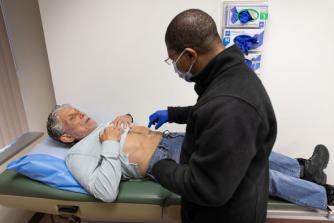
Complex care
As an academic medical center providing quaternary surgical care, Rush is able to handle most any type of surgical case, including complicated transplant procedures that other hospitals might not have the specialization to treat.
Specifically, Rush performs a large number of re-transplants in the Midwest — that is, patients who have undergone a transplant procedure, but where they experienced graft failure, rejection or significant allograft vasculopathy which led to a second transplant procedure.
Here, Dolamu Olatain, MD, MBBS, consults with Scott (left) prior to the day of surgery. Dr. Olaitan performed the surgery to remove Scott’s kidney for transplantation.
Fortunately for Scott and his sister Karen, their first experience with transplant was a success.
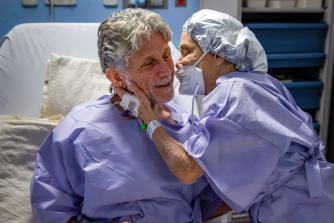
Transplants for elders
Scott and his sister Karen exchange a tender moment right before surgery.
Patients like Scott and Karen, who are in their 60s, may present unique challenges in transplant, especially if they are dealing with one or more comorbidities, such as high blood pressure or cardiac disease. But that doesn’t stop Rush, which treats the largest number of older adult transplant patients in the Midwest.
“We personalize therapeutic plans for elderly transplant patients, especially around immunosuppression,” Dr. Sela explains. “We may also put them on a prehabilitation plan for physiotherapy so that they can get through surgery safely.”
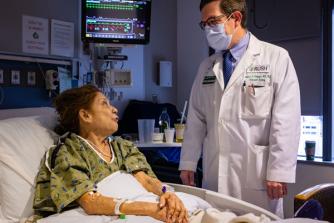
Follow-up
Following the surgery, Karen was seen by Edward Hollinger, MD, the surgeon who performed the kidney recipient surgery.
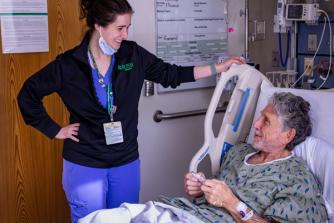
Scott talks with his niece, Sarah Repking, NP, DNP, the day following surgery.
Dr. Hollinger and Dr. Olaitan want to make sure patients are well-informed about the ways to ensure their long-term health either with a new transplanted organ or, in the case of kidney donors, to make sure they know how to best take care of their one kidney.
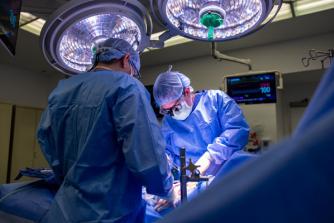
A national leader in outcomes
As a testament to Rush’s mission to make care available for all who need it, Rush treats the highest number of African American and Hispanic patients in the region and country.
In the process of addressing health care disparities, Rush also delivers superior outcomes in the process. Rush surpasses national, one-year survival rate outcomes in multiple categories: deceased donor kidney graft and patient, living donor kidney graft, kidney-pancreas graft and patient, deceased donor liver graft and patient.
For patients on the waiting list for transplant, 38.19% of Rush’s patients who receive a transplant within three years surpasses the national average of 36.26%.
Here, Dr. Hollinger performs the surgery to insert Karen’s new kidney from her brother.
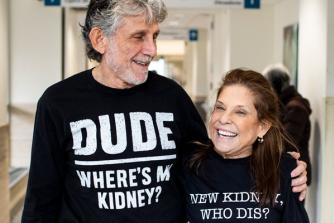
Twice the impact
Live kidney donation presents an opportunity to help two people at the same time.
“Not only does a live kidney donation help the person who needs it, but it also helps someone the donor will never meet,” says Aneesha Shetty, MD, MPH, section chief of kidney transplant at Rush. “There’s someone on the kidney transplant waiting list who gets bumped up because the person you directly helped gets removed. It’s such a wonderful gift.”
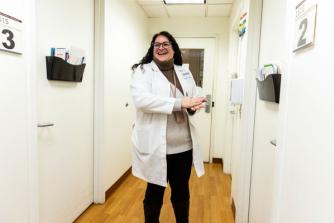
What lies ahead
Dr. Sela says that Rush is embarking on two initiatives that will help expand its reach to help even more patients. The first is introducing robotic living donor surgery, which will enable surgeons to operate safely on patients with a BMI higher than 35.
The second is connecting patients with a dietitian and providers who specialize in medical weight loss to help patients lose weight so they are eligible to receive or donate an organ.
“Weight loss is very difficult,” says Dr. Sela. “But with our expertise in weight loss at Rush, combined with some of the GLP-1 medications now readily available, we can expand transplant to patients who might not have been candidates before.”